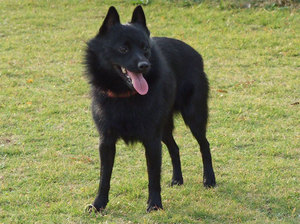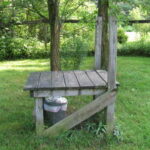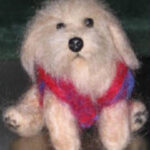The Schipperke (pronounced SKIP-er-key) is a small, quick, and energetic little dog. He is somewhat unusual looking with a fox-like face. He has a distinctive thick black “double fur” coat with longer outer hairs that are harsher to the touch over a soft, fluffier undercoat. He is sometimes born tail-less, but, if he does possess a tail at birth, the custom is to dock it such that no tail is visible (except in many parts of Europe, where this practice is illegal). If he has a tail, it usually curves over his back. Based on his appearance, many mistake him as a relative of the Spitz breed or a descendant of the Pomeranian. In truth, however, he was bred down in size from a 40-pound black sheepdog called the Leauvenaar to be a miniature watchdog
Schipperkes originate from the Flemish regions of Belgium. Originally, the breed was known as the Spits dog, or the Spitske and worked as a companion to tradesmen, for herding livestock, hunting game, or working as a guard dog. These dogs quickly, however, became popular as watchdogs and “ratters” on canal and river barges. In 1888, when a Brussels specialty club was formed, they were given the name Schipperke, derived from the Flemish word “schip” meaning boat. The nicknames “Little Captain” and “Little Skipper” were earned for their popularity and prowess on these boats. In truth, however, they were popular little watchdogs with other segments of the working class as well. Although English-speaking nations have interpreted the name “Schipperke” to mean “little sailor,” its derivation actually turns out to be the Dutch word “Shapocke” or “Scheperke”, meaning “little shepherd” based on its sheepdog heritage. The Schipperke was recognized as a breed by the American Kennel Club (AKC) in 1904. Today, it is part of their Non-Sporting Group.
The Schipperke can be a wonderful family pet, but no dog is perfect for everyone. As with any breed, there is variation from one dog to the next. They do, however, have some common characteristics. A Schipperke is a very loyal companion and watchdog. He is normally very healthy and will live a rather long life. Many Schipperkes have lived to be 16 to 18 years of age with little or no illness. He is very quick, energetic, and agile. He generally will possess a very confident and curious personality. He is usually very intelligent and naturally suspicious of strangers. These traits, combined with his keen senses, make him the excellent watchdog that he was bred to be. Some swear that he is a great dog with children of all ages. Others warn that he is often too quick tempered to be fully trusted with small toddlers. Perhaps an apt summary description might be inquisitive and intense (or high energy).
While small enough for apartment living and excellent on a leash, it may be difficult to satisfy the Schipperke’s activity level with walking alone. A fenced-in yard were he can roam and run would be preferable for this dog. Be warned, however, he can be clever at escaping yards that at first glance might seem secure. A Schipperke truly requires not only an outlet for his energy, but also the chance to exercise his busy mind. Activities such as obedience training, agility courses, and tracking are appropriate. Allowing him to become bored can result in excessive barking and/or destructive chewing.
While all dogs generally thrive with owners that are firm, confident, and consistent, this is especially key with dogs like the Schipperke. His strong likes and dislikes, or more bluntly, his stubborn streak, as well as the other characteristics that make him such a capable watchdog can also make him a little more difficult to train. This highly independent dog tends to resist being told what to do, and, hence, his housebreaking may take longer than other breeds. If the owner is not confident enough or often spoils his or her pet, this strong willed breed can be prone to a tendency towards bossy (acting as the alpha dog) or nippy behavior. While usually fine with pets in his own family, the Schipperke has a high prey drive and may be aggressive or try to dominate unfamiliar animals if such behavior is not checked. This is not meant to scare anyone away from this breed. If given adequate time and dedication, if properly socialized, and if from calm and stable breeding stock, the Schipperke can be fairly “laid back.”
Some breeds shed more than others. If this is a big concern, the Schipperke is probably not the best choice. You can expect a fair amount of shedding. You will need a good vacuum.
If you decide that the Schipperke is the right breed for you, it is normal to be excited and eager to get your dog. Patience, however, in finding a responsible breeder is the best way to locate a healthy, well socialized puppy. This is a crucial step in getting a well bred and healthy companion that will bring much joy and happiness to the lives of you and your family. While some Internet sites can be good sources for breeders, you have to be careful of those that are not selective about which breeders are allowed to advertise. Clubs for Schipperke enthusiasts are probably the most reliable source for identifying responsible breeders. The Schipperke Club of America provides a list of breeders on its web site. You can probably expect to pay about $600 for a Schipperke puppy. Depending on your source, though, there may be some available both well below and well above that ballpark projection. If you are willing to consider an adult, options such as rescue are also available. With an adult dog, you will have a better idea of the dog you are getting and have to worry less about breed characteristics. With a puppy, you must evaluate the “potential” of the dog he may become and hence the breed characteristics are a more valuable tool in this assessment.
Whatever dog you choose, you will likely quickly fall in love with it. With some patience, persistence, and caring, a Schipperke will become an acceptably trained, well balanced, and enjoyable pet. Be warned that he may be slow to mature (at about 18 months most Schipperkes seem to become more cooperative). He will require no special grooming – a good brushing every week should keep his coat in good condition. As with any dog, feed him properly, give him clean water, keep his teeth clean and his nails clipped, schedule regular vet check-ups, and keep his vaccinations current. Above all, offer him plenty of love and he will repay you many times over as an affectionate, loyal, and watchful companion.
Sources:
Michele Lowell, Your Purebred Puppy – A Buyer’s Guide, Henry Holt and Company, Inc., 1990, page 162
Nancy Baer and Steve Duno, Choosing a Dog – Your Guide to Picking the Perfect Breed, The Berkley Publishing Group, 19945, pages 199-200
AKC MEET THE BREEDS®: Schipperke, American Kennel Club, www.akc.org
Schipperkes – What’s good about ’em, What’s bad about ’em, www.yourpurebredpuppy.com
What is a Schipperke?, Central Rockies Schipperke Club of Greater Denver, www.schipperke.com
Schipperke Dogs: The Little Boatman, The Dog Pages, www.dogpage.us
Schipperke, Wikipedia, www.wikipedia.org








